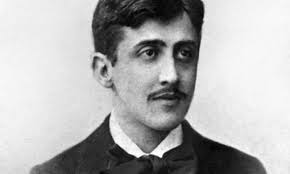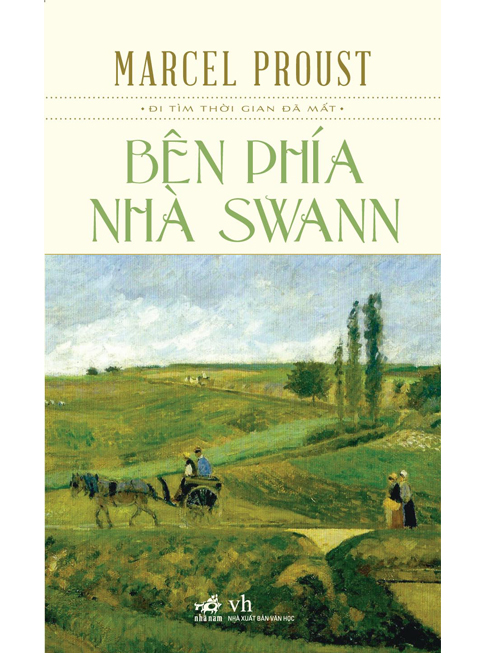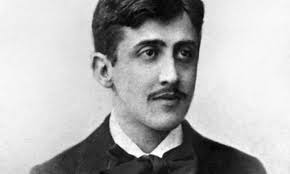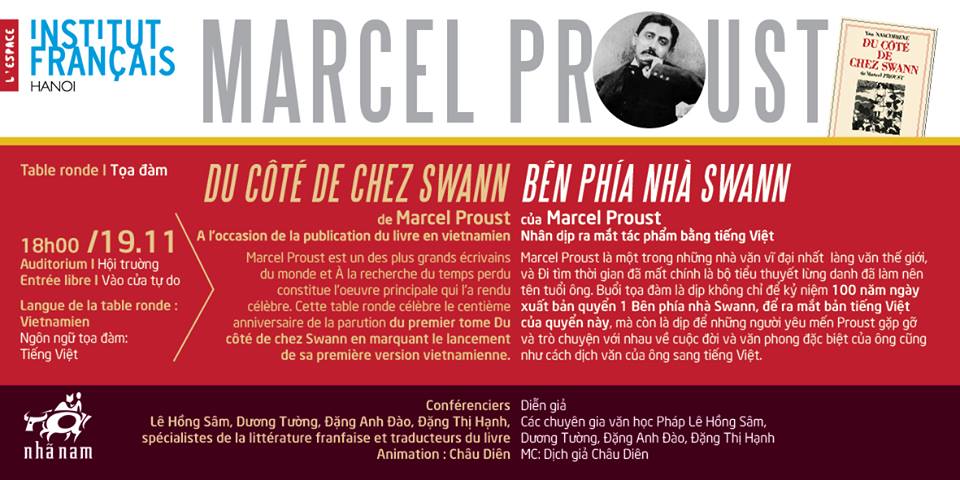

French writer Marcel Proust (1871-1922)
Among the authors and works mentioned above, Vietnamese readers have been fortunate enough to encounter them so far.Lolitaby Nabokov,The Case, The Castleby Kafka,Under the shadow of young girls in their primeandSwann's side(two of the seven volumes)Searching for lost time) by Marcel Proust.UlyssesThe works of James Joyce, an Irish writer, will likely take a long time (due to the particular difficulties in the author's writing style) to reach readers. Why is that? The answer is not difficult to find: perhaps the author intentionally created that timeframe. James Joyce once said, half-jokingly, that he wrote...UlyssesIt was to "create jobs" for university professors centuries to come: "I have included so many enigmas and puzzles in Ulysses that it will keep professors busy for centuries debating what I meant, and that is the only way to ensure the work's immortality."[1]Nabokov, the Russian-American writer, also recounted the difficulties he faced when publishing his work.LolitaHow and why did he have to write the same work in two versions, English and Russian, causing headaches for many translators? This is all about the publishing process.LolitaNabokov recounted that as soon as the manuscript was sent to the publisher, the editors immediately rejected it, even "threatening" him that they could "fall into jail" if they published such a work. The case of Kafka's works, the Czech writer of Jewish origin who wrote in German, was different. During his lifetime, Kafka only published one novella.Incarnateand some short stories. The remaining three are true novels.The case, the castle, AmericaBefore his death, he entrusted his manuscripts to his close friend Max Brod, also a writer, with the dying wish that they all be burned after his death. Fortunately, Max Brod, perhaps sensing his friend's talent in the writings he left behind, did not burn them. And the fate of three of the greatest works of 20th-century Western fiction went through many ups and downs before they were published, and even now they continue to be discussed and have consumed much ink from researchers. Max Brod recounted that after Kafka's death, he sent the manuscript to him.The case, the castle, AmericaHe sought the assessment of many people, including the writer Thomas Mann, one of the "giants" of German literature at the time. And he received an answer from this "giant" of German literature:My dear friend, I believe the author of these books is a good person, but he's just a bad writer.Whether Kafka was truly a "bad writer" or not, perhaps we have all now found the most accurate answer for ourselves (?).
Indeed, behind the creation of literary masterpieces, there are often quite a few complications. This novel...Searching for lost timeby Marcel Proust, especially volume 1Swann's sideEven at the time of its creation more than 100 years ago in France, there were similar "troubles." Very recently, through their efforts, a group of renowned translators have...[2]In Vietnam, with the assistance of the French Embassy, Nha Nam Cultural and Media Company, and the Literature Publishing House, the first Vietnamese translation of the seven-volume novel series has been published.Searching for lost time.Needless to say, the vast majority of readers were delighted to have their long-awaited expectations met by such a masterpiece! However, there were still a few voices expressing dissatisfaction. The dissatisfaction of some readers with a masterpiece like this...Swann's sideMarcel Proust's view is understandable. With a masterpiece, who wouldn't want the utmost perfection? To help readers better understand this, and to affirm the true value of the original work and the great efforts of the translation team, we would like to provide some additional information below, hoping that the essence of the matter will be more accurately understood by a wider readership. Due to the limited space of an article, we will only provide brief information surrounding three issues: The process of creating the novel.Searching for lost timeof Marcel Proust (1), what French researchers and publishers said about the book at the time of its publication (2), and the wishes and contributions of the translators (3).

Book cover"On the Swann side"
Marcel Proust was developing a series of novels.Searching for lost timefrom around 1909. InIntroductionIn the first volume of this series, translator Lê Hồng Sâm, who is also a long-time expert on French literature and represents the group of translators, wrote the following:From the beginning of summer 1909, Proust lived in seclusion, confined to his room with the door tightly closed, the floor, walls, and high ceiling all lined with layers of cork, so that not a sound could penetrate. He wanted from then on to live solely for his one great work. At night, he sometimes left the house, only to meet certain people he mentioned, in the process of recreating the vast mansion of his memories.”[3]It wasn't until 1927, almost 20 years later, that the seven-volume novel was published.Searching for lost timeIt has only recently been officially printed in its entirety. During his lifetime, Proust only managed to publish the first four volumes:Swann's side(1913)Under the shadow of young women in their prime(1919)Guermantes I(1920)Guermantes II's side, Sodome and Gomorrbe(1921). Proust died in 1922.The last three episodes:The girl was imprisoned.Published in 1923,Albertine, 1925 and the final volumeTime to find again, released in 1927. Among the 7 volumes of the series.Searching for lost timeVolume 1, The Swann Side is considered the most difficult to read, because in M. Proust's intention it was to bepreludefor the general scoreSearching for lost time.Swann's sideIt bore a great responsibility, like the "eldest child" in the family: it served as a prelude to finding a common tone, and simultaneously contained the author's explanations of his reasons for writing as well as the core issues of the work. Proust even had to pay out of his own pocket to print this volume. "The eldest child" in the family.Searching for lost timeIndeed, they have endured much notoriety and hardship, but as translator Dang Thi Hanh confided,Considering its literary value, especially in its many innovative approaches to the novel.“Many still consider it the ‘most valuable’ volume.” To better understand the “troubled” fate of the first book by the giant of 20th-century French fiction, we would like to present some opinions from two researchers considered “top experts” on Marcel Proust: Jean-Yves Tadié and Antoine Compagnon.

InMarcel Proust, Church of Time(Marcel Proust, La Cathédrale du temps) by Jean-Yves Tadié (Gallimard 1999), in sectionTestimony and documents(Testimonials and documents)There are sections with titles.The author was Most rejections in Paris, followed byFrom devastating attack to victory,Author Tadié stated the following:Everyone disliked Proust. Publishers were the first to raise the criticisms that would later be used against him: verbose, lacking plot, depicting high society. In short, a boring character. It took Proust a long time to achieve his fame. The Swann family only received acceptance from close friends. Conversely, *Under the Shadow of Young Women* was a different story.[4]Won the Goncourt Prize on December 10, 1919Elsewhere, Jean-Yves Tadié added: “People criticize Marcel Proust for not structuring his work, for being decadent, or a snob (following the trend), detached from life, writing in the Bourget style but poorly. Regarding the bookSwan's side, Rachilde wrote in the newspaperMercure de France: "I began reading the book with great enthusiasm, but in the end I had to abandon it in horror, as if one were refusing to take a sleeping pill.The press harshly criticized Proust. Not only that, but as soon as volume 2...Under the shadow of young women in their primeThe newspaper was founded, awarded the Goncourt Prize, and there were quite a few reactions surrounding the award.Populairewrite: "We veterans voted for Dorgelès. Marcel Proust won the prize thanks to the gratitude of the six people he treated well.The newspaperDebate(Journal des Débats) then it was harsh: “A talent from the grave, with little connection to the trends of the new generation, often extols the beauty of combat, the qualities of light."

French printSwann's side(Gallimard, Poche, 1992), annotated and introduced by Antoine Compagnon, also points out many things surrounding the publication of the book. InPrefaceAccording to Compagnon, both Fasquelle and Gallimard publishers rejected the manuscript. Gallimard based its decision on the comments of André Gide (who later regretted it), while Fasquelle relied on the report of Jacques Madeleine, who was assigned to read and comment on it (J. Madeleine was the pseudonym of Jacques Normand, whom Proust probably met in person and mocked in his writings).Les Plaisirs et les jours). The following is an excerpt from the report:After reading all seven hundred and twelve pages of the manuscript (...) – after the immense suffering of being submerged in unfathomable developments and the impatient frustration of never being able to emerge – we have no concept of the problem. What is all that for? What does all that mean? Where does all that lead? – It is impossible to know! It is impossible to say..
The letter accompanying the manuscript offers some explanation (Proust's letter to the Fasquelle publishers accompanying the typed manuscript - TH). But the reader of the book will likely not have this letter at hand. The letter confesses that nothing happens in those seven hundred pages, the action doesn't begin, or only begins on the last sixty pages, and in a way that anyone not warned would not notice. For the future character only appears there, and in a guise contrary to what he will later reveal. And how anyone would know that from him... no one can guess!
The letter declares that this entire first part is merely a “preparation,” a “poetic monologue.” A book longer than Zola’s longest novel, and yet it is only a preparation—that’s outrageous. And what’s even more damaging is that this preparation does nothing at all, and moreover, it doesn’t help predict what the letter alone reveals. Even with the letter’s hints, one still constantly wonders: but what is all this for? But what does it matter? What is it? What is it in the end? This is a clearly morbid case.”[5].
Aware of the difficulties that even within the French publishing and research circles had anticipated regarding the reader's reaction to the first volume ofSearching for lost timePublished in 1913, the Vietnamese translation team was very careful. Already diligent workers in teaching and research, I knew that since the early 1980s, all of them (Le Hong Sam, Dang Thi Hanh, Duong Tuong, Dang Anh Dao) had been exposed to French books and newspapers at the L'Éspace Center in Hanoi. They had read and loved Proust, along with many other writers. At this time, surrounding this masterpiece...Searching for lost timeMany research works by French and foreign experts have been published. Because of their love for Proust, they themselves have carefully read and considered his work. I also know that three of the translators spent months reading at the Ulm University of Education or the Mittérand Library, and frequently visited museums and memorials of great writers. With a lifetime of experience working with words, they surely possess sufficient knowledge and Vietnamese language skills to translate a foreign literary work, no matter how difficult.Swann's sideby Marcel Proust. Furthermore, if one doesn't have "ten years abroad to be able to translate" the works of a particular author (as someone said), then how could the great works of the world have been popularized in many countries, including Vietnam, for so long (?).
Despite our best efforts, as one translator in the group said:It's a pity we couldn't translate it better."Leaving a few errors is regrettable, but more importantly, they felt that few first translations could fully convey the "soul" of the work and the "voice" of Marcel Proust. A great French writer and also a "top-notch" translator (Yourcena) said:The truth is that there are still things that translation cannot fully convey, while the art of translation should aim to preserve everything. Therefore, we can never be completely satisfied.”[6].
This explains why great works like Proust's are translated so many times in countries around the world. Therefore, the door remains open to anyone who loves and wants to translate an author whose entire seven-volume work is known as "The Novel - Mother of 20th-Century French Literature." It is a very worthwhile endeavor.
[1]Cited by Tran Doan Nho,James Joyce, Ulysses, and the new challenge.Talawas, March 29, 2004
[2]Translators: Lê Hồng Sâm, Đặng Thị Hạnh, Dương Tường, Đặng Anh Đào
[3]. Quoted from Le Hong Sam, Introduction to M. Proust's *Swann's Way*, Literature Publishing House, 2013, p. 8
[4]The Vietnamese translation by Nguyen Trong Dinh is "Under the Shadow of Young Girls in Bloom," Volume 2, Literature Publishing House, 1999.
[5]. Quoted from Compagnon's Introduction inSwann's side, French version by Gallimard, op. cit.
[6]Marguerite Yourcena, "Eyes Wide Open",A dialogue with Marthieu Galey, La Centurion, 1980, p. 205
Author:Tran Hinh
Newer news
Older news